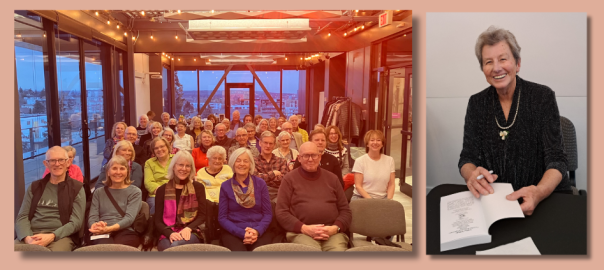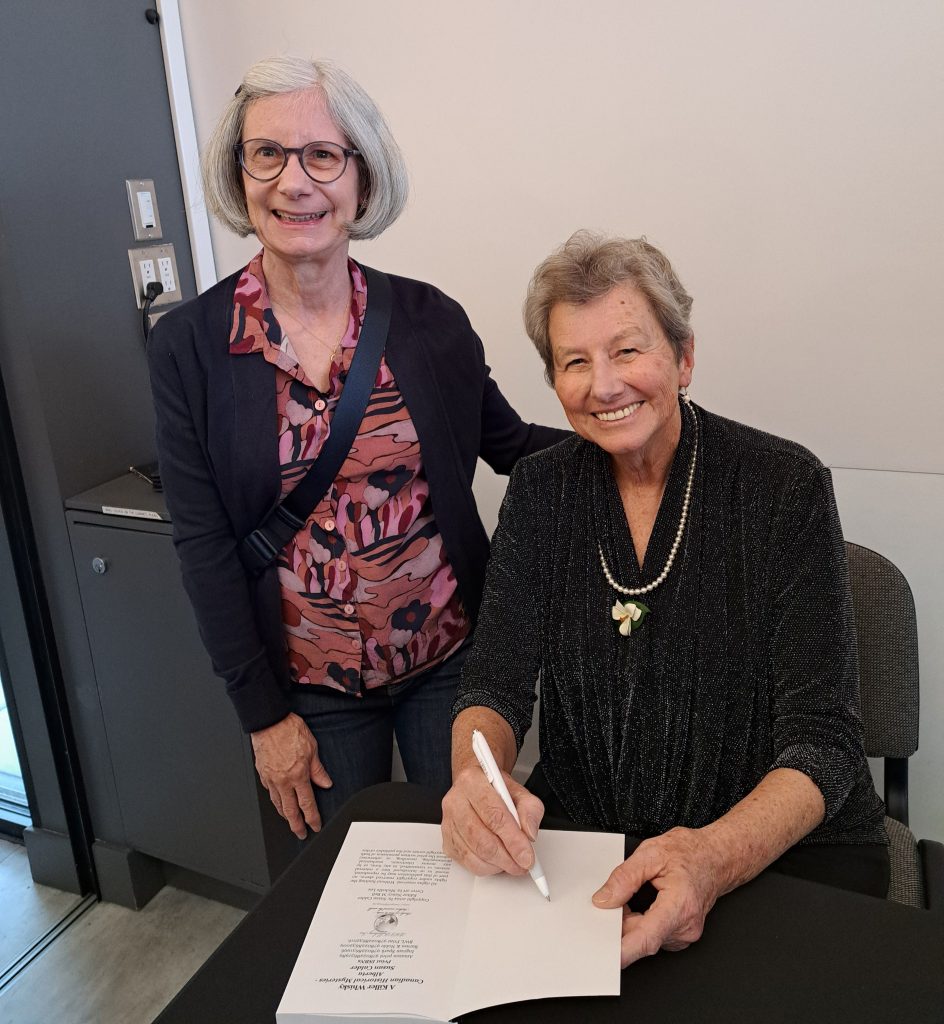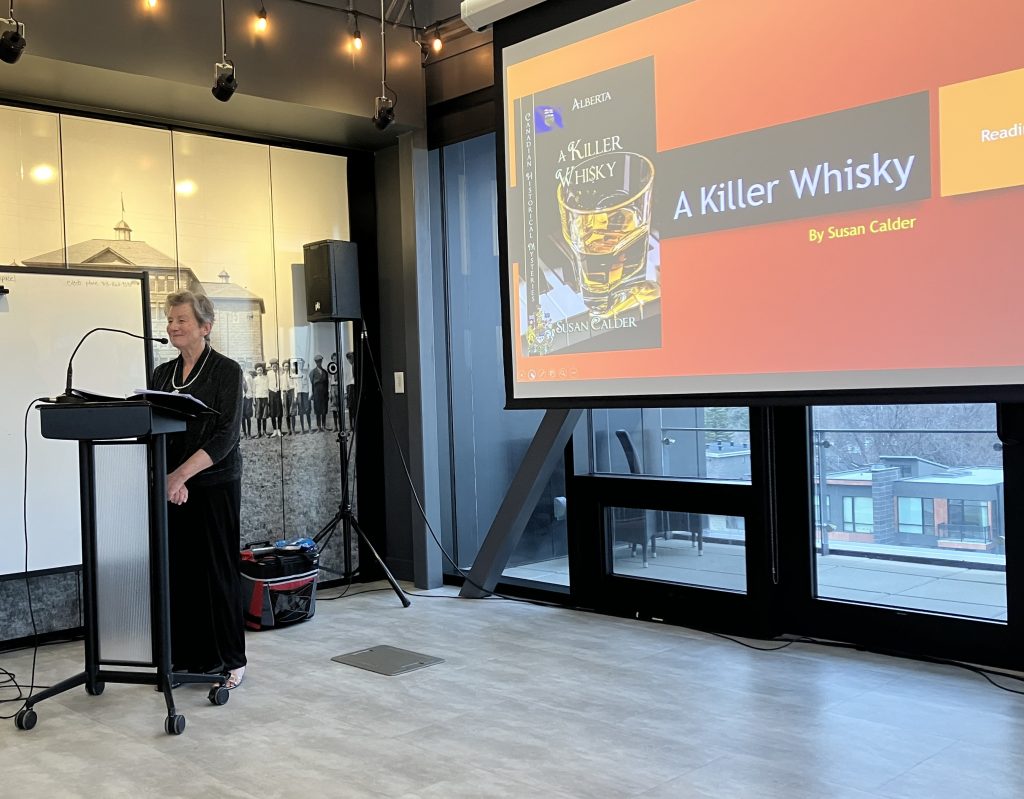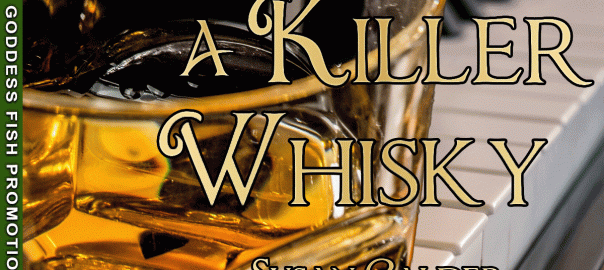
Tag Archives: #amwriting


Successful Book Launch for A Killer Whisky
I enjoyed my book launch for my new novel, A Killer Whisky, on Tuesday night. The weather co-operated with relatively mild temperatures and a hint of sunshine. Views from the Treehouse at cSPACE Marda Loop were lovely. It was especially great to see so many smiling, supportive faces and chat with newcomers and friends.

As part of the festivities, we offered “wee drams” of whisky and whisky cocktails named for some of A Killer Whisky’s characters. The most popular cocktail was “Katharine’s Patriotic Canadian Maple Whisky Sour.” Here’s the simple recipe:
Ingredients – yields one serving
1.5 oz whisky
1 oz lemon juice
2-4 teaspoons maple syrup
Pinch of ground cinnamon (optional)
Instructions
Fill a cocktail shaker or mason jar about 2/3 full with ice.
Add whisky, lemon juice, maple syrup, pinch of cinnamon.
Securely fasten the lid and shake well.
Pour ice into cocktail glass.
Add maple whisky sour mixture.
Enjoy!
This was my favourite cocktail, too, but I refrained from drinking at the launch to stay alert for my discussion of how I came to write A Killer Whisky and the history that forms a backdrop to the story.

My friend and Calgary literary historian, Shaun Hunter, did a fabulous job of hosting the event. Another friend and writer Leslie Gavel kept the slide show moving smoothly. Judith from Owl’s Nest Bookstore created a fine display of my six novels.

Most people seemed to go home feeling satisfied and enthused with the event. I couldn’t ask for better launch my novel, A Killer Whisky.

A Killer Whisky visits another website
Check out BWL author J. Q. Rose’s website https://www.jqrose.com/2025/03/focus-on-books-series-guest-susan.html for her feature on A Killer Whisky. I discuss the origins of the novel and J. Q. reviews A Killer Whisky. J. Q. lives in the United States and questioned why “whisky” isn’t spelled “whiskey” in the title. She explains the different spellings in her post, and I had a character in my novel explain it so Americans won’t think I don’t know how to spell.

Preparing for the Book Launch on March 25th
My book launch for my new mystery novel A Killer Whisky is ten days away. I’ve spent the past month on preparation, and there’s still plenty to do.
An easy task was to create a Facebook Event Page and invite about 160 Facebook friends who live in the Calgary area. So far, nine have said they’re going. This might not seem like a lot, but some will bring a friend, not all attendees confirm, and part of the purpose is to let people know my new book is available. I drop into the Event Page daily and make occasional comments to generate interest. One friend told me my Event Page shows up regularly on his Facebook feed, possibly because he presses “like” whenever the page appears. From other “likes” to the page, I notice that friends I didn’t invite have seen it. Thus, the page becomes continuous promotion for relatively little effort on my part.
For friends who aren’t active on Facebook, I created a poster that I email to them individually. This takes more time than a mass mailout, but I think the personal approach prompts more people come. People usually reply, whether they can go or not, and it’s fun to catch up with those I haven’t seen in months or longer. I contact everyone who’s shown an interest in my writing and especially those who have attended previous launches. It helps to keep an attendance list and look back at previous launch pictures.
In addition, I’ve sent notices about the launch to my writing groups for inclusion in their weekly or monthly newsletters to members. Few people will attend as a result of these announcements, but some might buy the book and read it if it strikes them as interesting.
I’ve also started work on the launch program, which will centre on my PowerPoint presentation. I enjoying doing PowerPoints and work hard to find the right image or bullet points to compliment what I want to say. My talk will focus on my inspirations for writing A Killer Whisky, setting locations in Calgary, and the novel’s historical background – the story takes place during the 1918 Flu Pandemic, World War One, and Alberta Prohibition. I still need to create more slides and tweak existing ones to make the newspaper headlines, advertisements, photographs, and cartoons more effective.
A week before the launch, I’ll get a dress rehearsal for the PowerPoint presentation at the Pincher Creek Municipal Library, where I’ll discuss the historical events relevant to an audience in Southern Alberta. Both the Pincher Creek Author Talk and Calgary Book Launch will include readings from the novel, which I still have to select, practice, and fit into the program.
Other ingredients for the book launch event are food and drink. Since “whisky” is in the novel’s title and plays a key role in the story, I’ve pursued my idea of serving “wee drams” of whisky and whisky cocktails named for the story’s characters. A few weeks ago, I knew little about whisky cocktails other than that I’d liked Whisky Sours when I was younger. From the internet I’ve now learned about bitters, muddlers, and channel knives for making lemon twists, and I’ve found cocktail recipes that my husband and I are experimenting with this week. Our first attempt was a success! Cinnamon Maple Whisky Sour will be the signature drink for my protagonist Katharine, a Canadian patriot who supported the Great War.
Between now and the launch on March 25th, I’ll need to shop for snack platters, lemons for my mixers and twists, and door prizes with whisky, mystery, and/or history slants. I still need to finalize arrangements with my bookseller, Owl’s Nest Bookstore. No doubt myriad details requiring attention will come up. Let’s hope for no last-minute disasters, like a snowstorm – not unusual for Calgary in March – or a key person like me coming down with the flu.
Is the book launch worth all this time, effort, money, and stress?
I don’t know.
But it is fun to plan a party.
Cheers to everyone who loves writing and reading books!

Book Launch Plans
On today’s BWL Author Blog, I write about my continuing plans for my book launch for A Killer Whisky on March 25th. https://bwlauthors.blogspot.com/

Last Day of my virtual book tour
I have two stops for this finale day of my blog blitz tour. Here they are:
Our Town Book Reviews:https://www.ourtownbookreviews.com/2025/02/a-killer-whisky.html?sc=1741358052467#c5823763710522951092
The Avid Reader: Blurb Blitz + #Giveaway: A Killer Whisky by Susan Calder @GoddessFish | The Avid Reader
This whirlwind tour has been an interesting ride. Thanks to Goddess Fish promotions for organizing the tour, to the 15 reader websites for hosting A Killer Whisky and helping to connect readers and writers, and to the interested readers who posted comments about my book.

“I Dig Books”
On today’s virtual book tour, A Killer Whisky visits “Archaeolibrarian–I Dig Books” https://archaeolibrarian.wixsite.com/website/post/review-giveaway-a-killer-whisky-alberta-canadian-historical-mysteries-by-susan-calder Leave a comment on the site for a chance to win the giveaway prize donated by BWL Publishers.
Only one more day to go on my blog tour. Hard to believe it’s almost over.

Busy Day on my Virtual Book Tour
Today I have two blog stops: Dawn’s Reading Nook https://dawnsreadingnook.blogspot.com/?zx=421cc8dee075e536 and Westveil Publishing Westveil Publishing – Jenna Rideout | Illustrator, Book Reviewer, Author, and I’m heading out with my hiking group for a two-hour walk in Griffiths Woods this morning. How do I find the time?

“Fabulous and Brunette”
Today’s whirlwind blog tour takes me to Fabulous and Brunette blogspot. https://fabulousandbrunette.blogspot.com/ If you make a comment you have a chance to win a prize donated by BWL Publishing Inc.

Two reader blog visits
After my weekend break, I’m back to my blog blitz tour with visits to two reader sites. Check them out to win a giveaway prize donated by BWL Publishing Inc. Here’s the link to “A Wonderful World of Books” “https://awonderfulworldofwordsa.blogspot.com/2025/03/a-killer-whisky-alberta-canadian.html
And here’s “Iron Canuck Reviews and More:” https://ironcanuckreviews.blogspot.com/2025/03/blitz-killer-whisky-alberta-canadian.html